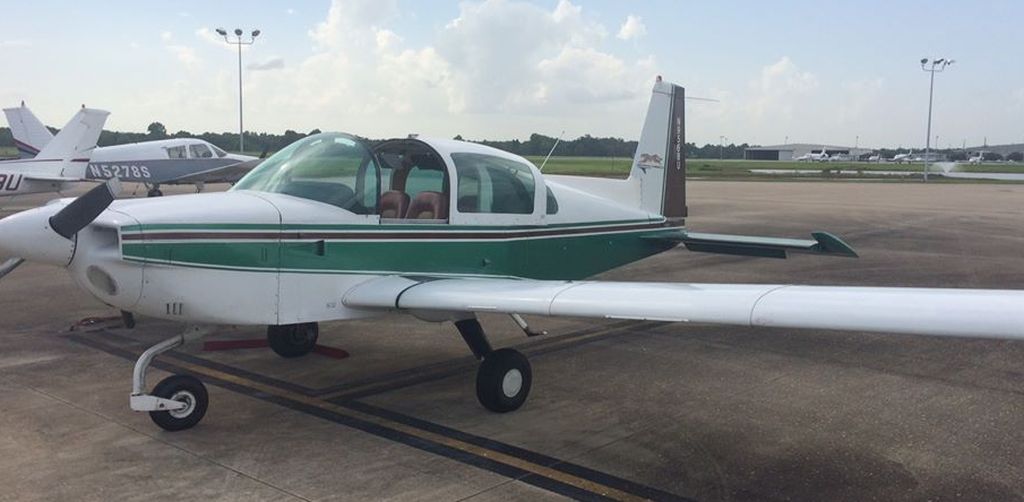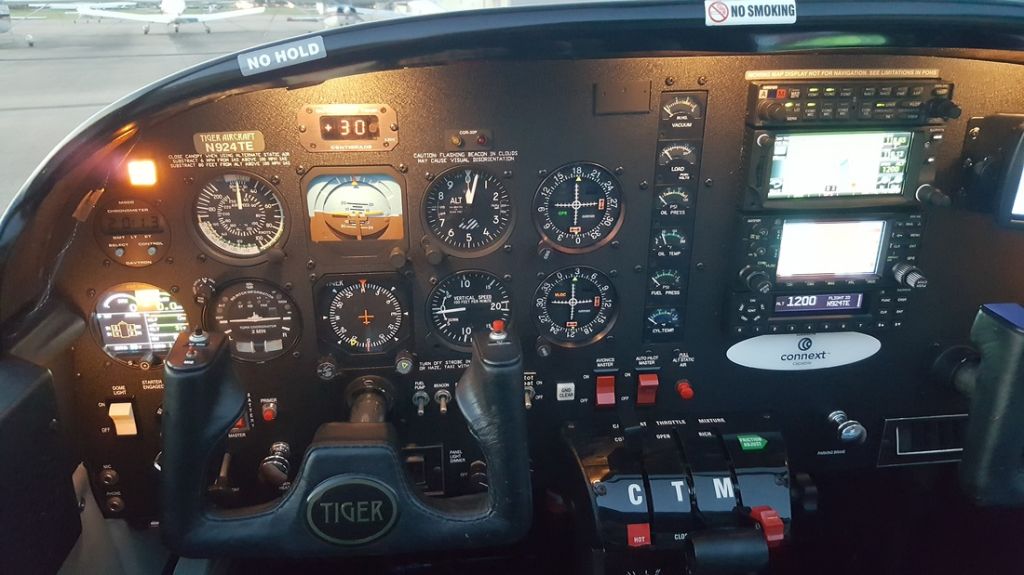When Michael Bletsch was looking for the perfect airplane to start Aero on Demand, a non-equity club based at Sugar Land Regional Airport (KSGR) just west of Houston [see this month’s Club Spotlight], he did some research and settled on the Grumman Tiger. “If you really put pencil to paper and add up the performance you get with the Grumman, compare it to what you get with a Cessna. I studied,” Mike said. “I looked at a Cirrus SR-20, 172s, Pipers—[with a Grumman] you get a lot of airplane for your dollar.”
He also made cold calls to Grumman owners. He spoke to about a half a dozen owners and “the consensus was they’re reasonable airplanes, maintenance friendly and insurance friendly,” Mike said. The club started with the Tiger, which seats four, has a 180-hp engine, and has added a Cheetah, which is basically the same airplane as the Tiger with a 150-hp engine. Both are well suited for primary training or cross-country flying with the right equipment.
Operating Cost: 4
Maintenance: 4
Insurability: 4
Training: 4
Cross Country: 3.5
Fun Factor: 3.5
Overall: 3.8
When talking about a Tiger, the term ‘Bang for the Buck’ comes to mind. “The operating cost is really low. I can really nail it down because we’ve got the engine monitor in there,” Mike said. “Between 4,000 feet and 10,000 feet, depending on temperature, it gets between 8.3 gph to 9.2 gph and you’re doing 135 knots easy.” With a power setting of 2550 rpm to 2600 rpm, Mike usually cruises between 135 and 138 knots.
Aero on Demand charges $55 an hour, Tach time, dry and fuel prices were $3.85 a gallon at the time of writing, so about $35 to $40 an hour.
Grumman produced the AA5B Tiger from 1975 through 1979, American General produced 181 AG5B Tigers from 1991 through 1993, and from 2001 to 2005 Tiger Aircraft produced 51 AG5B Tigers. Aero on Demand has a 2001 AG5B.
Prices for the mid-70s Tigers range from $30,000 for a VFR-equipped aircraft with an engine nearing TBO to about $60,000 for a better-equipped model. The later versions produced in the 1990s and 2000s will cost a bit more with prices in the $75,000 to $100,000 range.
Maintenance (4 stars)
It’s a fixed gear, fixed-pitch prop aircraft so there are fewer things that may need repair. “You get a bang for your buck in maintenance," Mike said. “Annuals are simple.” There is a company called FletchAir in Comfort, Texas that specializes in Grumman parts and maintenance. Aero on Demand used them for its annual, which cost about $1,700, but Mike said you pay a premium for their service. Otherwise, he estimated an annual with no squawks would run in the $1,200 range, depending on the going hourly rate your mechanic charges.
Parts are easy to get, Mike said, with the exception of wheel pants. He paid $1,200 for a set for the club’s Cheetah and said he had to look long and hard to find them. The only concern to watch for is a 12,000-hour wing spar AD, but it’s unlikely most aircraft will reach that flight time.
Insurability (4 stars)
One of the reasons Aero on Demand chose Grumman aircraft is they are a known airframe and easy to insure. The club pays $5,200 a year. The hull is insured at $145,000 with $1 million liability. They have an unnamed policy, meaning they don’t have to list their members or their flight time, so anyone who joins the club is insured.
Training (4 stars)
Aero on Demand requires members to already have their Private Pilot Certificate and 100 hours of flight time, but Mike would recommend the aircraft as a primary trainer. With a fixed-pitch prop and fixed gear, it’s simple to operate. However, the aircraft is very responsive so CFIs need to keep a careful eye on students who may over control the aircraft.
The club does use its aircraft for IFR training and to practice the maneuvers required for the commercial certificate. A flight school based at Sugar Land has an Arrow, which club members can rent to get proficient in complex operations – retractable gear, flaps, and a constant-speed prop.
Both the Tiger and Cheetah have a free-castering nose wheel so steering is accomplished through differential braking, which takes a little more skill than on an aircraft with nose-wheel steering.
Cross-Country Travel (3.5 stars)
One of the things that distinguishes Aero on Demand is that it has a 7:1 member to aircraft ratio that allows members to take the plane for longer cross countries. Members have flown from Texas to Arizona, Arkansas, Kentucky and New Orleans, not to mention trips within Texas that would be an eight to nine hour car ride. Mike chose the Tiger for its speed and efficiency. “What you get in nautical miles per gallon is very impressive,” Mike said. “Besides the RV, it’s the fastest 180-hp airplane out there with a fixed-pitch prop. It will keep up with an Arrow. It will keep up with a 182. They’re fast little airplanes.”
It holds 52 gallons and has a range of about 700 miles. The one disadvantage is usable load. With full fuel, the payload is about 600 pounds or so – plenty if it’s two people flying with luggage. If you have four people, filling up to the tabs provides 38 gallons of fuel, and you should be fine. The Cheetah’s useful load is about 530 pounds, so the club policy is to refill the plane to the tabs.
 Aero on Demand’s Tiger has an S-Tec autopilot and the Cheetah has a factory-installed Century 1 autopilot, and both are equipped with a panel-mounted Garmin GPS, making the aircraft a good cross country platform in VFR or IFR conditions. “Both of them are awesome cross country machines,” Mike said.
Aero on Demand’s Tiger has an S-Tec autopilot and the Cheetah has a factory-installed Century 1 autopilot, and both are equipped with a panel-mounted Garmin GPS, making the aircraft a good cross country platform in VFR or IFR conditions. “Both of them are awesome cross country machines,” Mike said.
Fun Factor (3.5 stars)
“Every day a hop in that airplane is like a kid in a candy store,” Mike said. The planes have pushrods instead of cables making the controls very responsive. “It’s super tight on the controls. If you touch it, it’s going to move an aileron or elevator. You can literally fly with your pinkies.”
It also has a sliding canopy, which can be opened in flight, and excellent visibility. “In the Tiger you sit high in the saddle,” Mike said. “[Compared to a Cessna,] it took a little bit to get used to, but once you do, man this is nice.”
The bonded aluminum construction eliminates the need for rivets, so even sitting on the ground it looks sleek.
Overall (3.8 stars)
If your club is looking for an economical aircraft that can serve as a primary trainer and a solid cross-country platform with good performance, the Grumman Tiger is a plane you may want to consider. It’s nimble in the air, seats four and has a good cruising speed for minimal fuel burn.
“I think they’re just an under publicized airplane to be honest with you. Like a 172, it’s a proven airframe, they’ve been around since the early 70s,” Mike said. “And there is a tight following with them too.” Mike couldn’t find a single Tiger owner who had something negative to say about the plane. “You can tell from what’s on the market, there aren’t many for sale out there.”